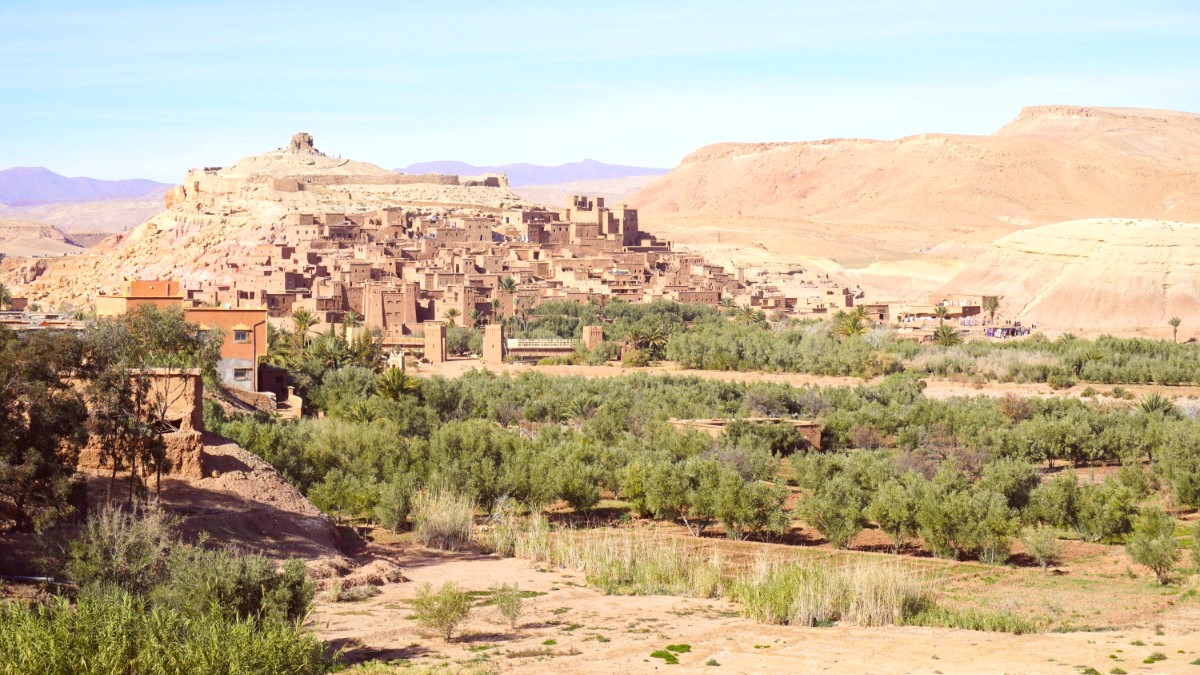
Morocco
Moroccan cuisine is a complex fusion of Berber, Arab, Moorish, and Mediterranean influences, with subtle European and sub-Saharan notes. This blend developed over centuries through trade, conquest, and migration.
It is known for its aromatic spices, the slow-cooking technique of tagines, and the generous use of fresh vegetables, fruits, and herbs. The food shares stories of Morocco's diverse history and geography.
In Ait Ben Haddou and Ouarzazate, cuisine emphasizes traditional Berber dishes. These are simpler, more rustic than imperial city dishes. Focus on local vegetables, grains, and sometimes goat or lamb. Tagines and couscous are staples. Meals reflect the desert and mountain environment.
Hands are often washed before meals. Many meals are served in communal dishes; eat with your right hand. Bread is central to scooping food and sauces. Mint tea is a strong sign of hospitality; accepting it polite. "Bismillah" a polite phrase before eating. Meal times are family affairs.
Breakfast (Ftour) is light: bread, olives, honey, jam, mint tea/coffee, served by guesthouse. Lunch (Ghada) is often the main meal for locals. Dinner (Asha) usually later (8 PM or after). Many guesthouses serve a fixed three-course dinner menu.
The iconic Moroccan slow-cooked stew, named after its conical earthenware pot. Varieties include chicken with preserved lemon and olives, beef/lamb with prunes and almonds, and vegetable tagine. Widely available at guesthouses and local restaurants.
A flavorful and aromatic centerpiece of Moroccan cuisine.
Steamed semolina grains served with tender meat (chicken, lamb, or beef) and a medley of vegetables (carrots, zucchini, cabbage, chickpeas). Traditionally prepared and served on Fridays as a family meal, often available on other days in tourist-oriented restaurants.
A communal dish, embodying shared meals and tradition.
A hearty and flavorful Moroccan soup. Often contains tomatoes, lentils, chickpeas, and a small amount of lamb or beef. Popular during Ramadan to break the fast, but available year-round in many eateries.
A nourishing and comforting soup, rich in flavor.
Brochettes are skewered grilled meats, often chicken or beef, with Moroccan spices. Bocadillos are Moroccan-style sandwiches, typically on a baguette, filled with meat, tuna, or vegetables.
Msemen are square, flaky flatbreads. Kaab el Ghazal (Gazelle Horns) are crescent-shaped pastries with almond paste and orange blossom water. Both are popular snacks/desserts.
Fine dining options are very limited or non-existent in Ait Ben Haddou itself. For an upscale dining experience, travel to larger hotels or restaurants in Ouarzazate.
Several guesthouses in the new village have their own restaurants, serving traditional Moroccan cuisine, often with fixed dinner menus. Excellent places for home-cooked meals with ksar views.
Small local cafes and snack shops exist in the new village. They offer simple, affordable Moroccan fare like sandwiches, omelets, and basic tagines. True street food stalls are limited.
No large markets or food halls in Ait Ben Haddou. Small local shops sell basic provisions like bottled water, snacks, and fruits. For a larger souk with fresh produce and spices, visit Ouarzazate.
Ouarzazate offers a more authentic market experience.
International cuisine options are extremely limited in Ait Ben Haddou. The focus is almost entirely on Moroccan cuisine. If you crave international food, Ouarzazate offers a few more choices, typically within larger hotels.
Embrace local flavors for the true experience.
Vegetable tagine and couscous are staples. Vegan requires clear communication to avoid animal fats (smen).
All meat is halal. Kosher food not widely available; bring provisions or arrange specialized catering from larger cities.
Challenging as many staples contain wheat. Confirm ingredients in tagines and other dishes.
Nuts, dairy, gluten are common. Consider carrying an allergy translation card.
Gluten-Free: More challenging. Couscous and most Moroccan bread (khobz) are wheat-based. Tagines without couscous or bread can be gluten-free, but confirm ingredients.
Allergens: Nuts (almonds in pastries), dairy, and gluten are common ingredients. If severe allergies, bring an allergy translation card.
Phrasebook/Translation App: Learn basic Arabic or French phrases like "Bila laham" (without meat), "Bila hlib" (without milk), "Ana alergic li..." (I am allergic to...).
Translation Card: Carry a translation card in Arabic or French clearly explaining dietary restrictions. Show this to restaurant staff.
Inform your guesthouse in advance about any specific dietary requirements. They are often very accommodating, especially for breakfast and dinner meals served on-site.
Do not be afraid to try street food, especially in Ouarzazate. Look for stalls with high turnover and visible cleanliness to ensure freshness.
Some guesthouses in Ait Ben Haddou or Ouarzazate may offer informal cooking demonstrations or classes, specifically for preparing tagine and mint tea.
No specific organized farm visits are available in Ait Ben Haddou. The surrounding area features palm groves and small agricultural plots, but these are generally for local consumption.
No major food festivals are unique to Ait Ben Haddou. Regional festivals in Ouarzazate or nearby towns might feature local culinary traditions as part of broader cultural celebrations.
Guesthouses prioritize personalized service, often tailoring meals or experiences to guest preferences with advance notice.
This intimate setting offers a window into local life.
The most authentic culinary experiences are found within the guesthouses themselves, where meals are often prepared by the family running the establishment.
Savor the genuine flavors of Berber hospitality.
Dishes emphasize fresh, locally sourced ingredients from the surrounding fertile valleys and gardens.
The use of a rich variety of spices defines the flavors, creating a sensory journey with every meal.
Tagines and other traditional dishes are slow-cooked, allowing flavors to meld and meats to become exceptionally tender.
Always confirm ingredients if you have specific allergies or dietary requirements. Local hosts are often very accommodating.